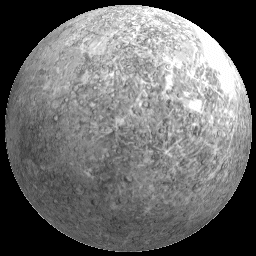
Mercury
Mercury is the closest planet to the Sun and is like our Moon in
many ways. It has almost no atmosphere and it is scarred from
thousands of impact craters (3). The tiny atmosphere that Mercury
has is mostly made up of hydrogen, helium, and sodium (1). The
craters on Mercury appear nearly the same as they did when they
were created because of its very thin atmosphere. Without an
atmosphere there is no weather and without weather there is no
erosion to wear away the craters (1). Other than craters, Mercury
is covered with long, steep cliffs, some of which cut across the
surface for hundreds of kilometers (1). Mercury also has vast
plains that were probably formed by flowing lava, although there
is no evidence of any active volcanoes on Mercury today (1). One
of the largest features of Mercury is the Coloris Basin, which is
about 1300 km in diameter and is a result of an asteroid impact
on Mercury’s surface early in the solar system’s
history (3).
Of all the planets, Mercury has the quickest revolution at 48
km/s, and it takes only about 88 Earth days to complete one
revolution. (1). Because of this, it was named after the speedy
messenger of the Roman gods (1). Mercury has a slow rotation
(about 59 Earth days in one Mercury day), however, which allows
it to heat up during its day and cool down during is night.
During the day, Mercury can reach temperatures up to 427* C and
can plummet down to –170* C at night (1). Mercury is about
58 million kilometers from the Sun, has a diameter of 4880 km,
has no moons, and is the second smallest planet next to Pluto
(1).
